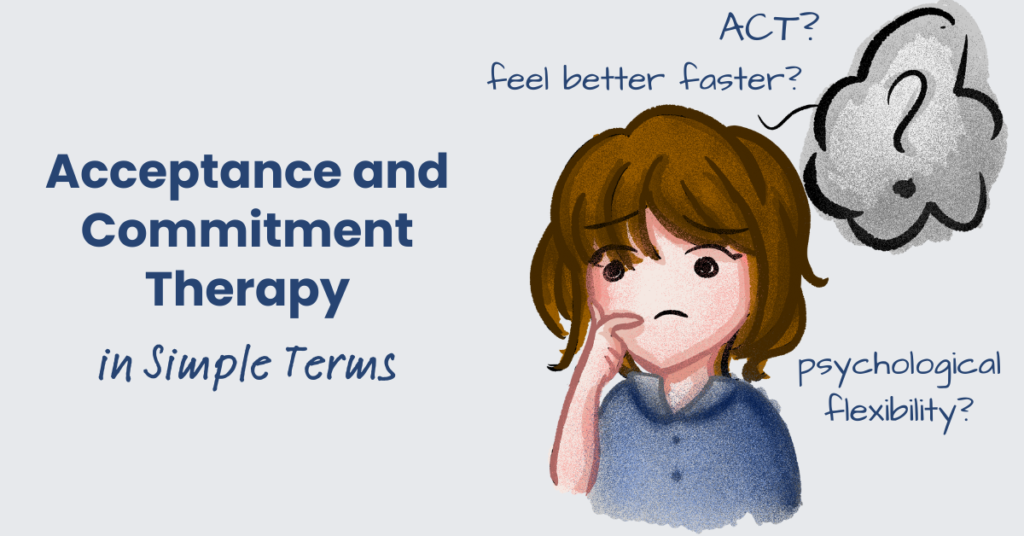Acceptance and Commitment Therapy (ACT) is a form of psychotherapy that encourages people to accept painful thoughts, emotions, and situations instead of denying or avoiding them. ACT is built on the idea that agonizing or struggling over what you don’t like can make things worse. But if you can accept them as part of the human experience, then you can move on from it faster and focus on what truly matters—living a life guided by your values.
The main purpose of ACT is to help you develop psychological flexibility, which is the ability to roll with life’s punches without being overwhelmed. Life is not perfect. You WILL encounter hardships and struggles, but if you’re psychologically flexible, then you can stay in the present moment (practice mindfulness), adjust your actions (instead of letting your emotions dictate your behavior), and continue to pursue what matters most to you, even when you are being hit by challenges left and right.
ACT: A Brief History
ACT was developed in the 1980s by psychologist Steven C. Hayes. It emerged from behavioral psychology but took a different approach than traditional cognitive behavioral therapy (CBT). While CBT focuses on changing negative thoughts and behaviors, ACT encourages people to change their relationship with those thoughts and emotions. Hayes’ research emphasizes that acceptance, rather than resistance, leads to less misery and suffering from the things in life that you don’t like or find difficult.
Hayes’ approach to therapy was groundbreaking because it encouraged patients to accept their feelings, thoughts, and circumstances—no matter how unpleasant—instead of avoiding them. This shift in perspective forms the backbone of ACT therapy today.
What Are the Benefits of ACT?
The primary benefit of ACT is psychological flexibility. This term means that instead of being stuck in emotional pain, you can adapt to changing circumstances with resilience and clarity. Here are some of ACT’s key benefits:
- Reduced Anxiety and Stress. By learning to accept uncomfortable thoughts and feelings, you are less likely to feel overwhelmed by anxiety and stress.
- Improved Emotional Regulation. ACT teaches mindfulness techniques, which help you observe your thoughts and feelings without judgment.
- Enhanced Mental Clarity. Learning to live in the present moment reduces mental clutter and helps you stay focused on your goals.
- Increased Resilience. If you can accept and adapt to difficult emotions or life challenges, you become more resilient in the face of future stress.
- Living a Value-Based Life. People are usually unhappy when there’s a mismatch between how they’re living and their deep inner values. ACT encourages you to align your actions with your core values, leading to greater life satisfaction.
What Are the Six Core Processes of ACT?
ACT therapy is built on six core skills, each aimed at developing psychological flexibility. These techniques work together to help you better cope with uncomfortable thoughts, emotions, and challenges:
- Acceptance. The first core process in ACT is to fully accept your thoughts and emotions without trying to change or suppress them. Acceptance is about acknowledging reality AS IS, even if it’s uncomfortable or painful.
Example: You have a presentation you need to do at work. You’re anxious and keep thinking, “I’m going to mess up in front of everyone.” Instead of trying to push away the anxiety, you acknowledge it. You say to yourself, “I’m feeling nervous, and that’s okay. Most people feel this way before a big presentation.” Accepting your anxiety instead of fighting it helps prevent you from feeling worse. - Mindfulness. ACT encourages mindfulness or staying aware of the present moment. This involves grounding yourself in the here and now rather than getting lost or “marinating” in past regrets or future worries.
Example: You have a presentation to do, and as the date approaches, you notice your mind drifting to “What if I forget my points?” or “I should have prepared more.” Practicing mindfulness, you focus on the present and tell yourself, “Right now, I’m preparing, and that’s what matters.” You take a few deep breaths and bring your attention back to the moment. - Cognitive Defusion. This technique helps people distance themselves from their thoughts. Instead of getting caught up in negative or unhelpful thinking, ACT teaches you to observe your thoughts as just that—thoughts—temporary experiences that shouldn’t control your actions.
Example: You have a presentation to do, and just before it, a thought pops up: “I’m going to embarrass myself.” Instead of believing this thought, you practice cognitive defusion by recognizing it as just a thought, not a fact.
You tell yourself, “I’m noticing that I’m having the thought that I’ll embarrass myself. But it’s just a thought; no need to let it control me.” This helps you detach from the thought’s power over you. - Self as Context. This process involves seeing yourself as separate from your thoughts and experiences. It’s the idea that you are not your thoughts or emotions; rather, you are an observer of them. This shift helps to reduce the intensity of negative thoughts and feelings.
Example: As you defuse yourself from feelings of nervousness about your presentation, you remind yourself that while you’re feeling nervous, you’re more than your anxiety. You think, “I’m feeling anxious right now, but that’s just one part of me. I’m also someone who’s capable; I have done well in previous presentations.” Viewing yourself as the observer of these feelings allows you to keep perspective and reduces the intensity of your nervousness. - Values Clarification. ACT emphasizes identifying what truly matters to you—your core values. These values act as your compass in life, guiding your decisions and actions.
Example: To refocus, you think about why this work presentation matters to you. Your core values include growth and helping others, and giving this presentation aligns with both. You decide, “I’m doing this because it aligns with my goals to grow professionally and support my team.” This value-based perspective gives the presentation a deeper meaning. - Committed Action. Finally, ACT encourages taking meaningful action that is in line with your values. This step involves committing to behaviors that align with your values, even when faced with challenges or discomfort.
Example: Despite feeling anxious, you choose to proceed with the presentation. You might feel discomfort, but you’re committed to presenting because it reflects your values. As you start, you practice mindfulness and FOCUS on delivering your message, staying true to your values of growth and support for your team, even though it feels challenging.

Want to use this infographic? Great! Feel free to download it, but please credit LifeZen by linking back to this article.
Who Would Benefit from Acceptance and Commitment Therapy?
ACT is effective for a wide range of mental health challenges, making it a versatile therapy option. Some of the conditions ACT is especially helpful for include:
- Anxiety Disorders. ACT can help people with anxiety by teaching them to accept and manage their anxious thoughts and feelings without becoming overwhelmed. (Reader Recommended: ACT Therapy Workbook for Anxiety Relief.)
- Depression. For people with depression, ACT offers tools for accepting negative emotions and refocusing on positive, value-driven action.
- Chronic Pain. ACT has been shown to help individuals cope with chronic pain by accepting physical discomfort and focusing on meaningful activities.
- Eating Disorders. Through acceptance, people can learn to sit with difficult thoughts about food, eating, and body issues without resorting to food for comfort. Mindfulness encourages being present during meals, helping to reconnect with natural hunger and fullness cues. ACT’s emphasis on values also helps. For example, if you value health, relationship with self, or personal growth, ACT can help guide your actions in line these values
- OCD (Obsessive-Compulsive Disorder). ACT teaches individuals to accept intrusive thoughts and commit to value-based actions rather than being controlled by their obsessions or compulsions.
- PTSD (Post-Traumatic Stress Disorder). The mindfulness and acceptance techniques in ACT are useful for reducing trauma-related symptoms and promoting healing.
- Addiction and Substance Use. ACT helps people overcome addiction by focusing on acceptance and commitment to values, reducing the need to escape uncomfortable emotions through substances.
Important: ACT is not just for those experiencing mental and emotional challenges. It is also highly beneficial for anyone who wants to improve their emotional well-being and increase their resilience.
Who Would NOT Benefit So Much from ACT?
While ACT is a flexible and widely applicable therapy, it might not be suitable for everyone:
- Severe Mental Health Crises. Individuals experiencing acute mental health crises (such as psychosis or suicidal ideation) may need more immediate and direct forms of therapy or medical intervention before starting ACT.
- People Resistant to Acceptance-Based Approaches. Some individuals may prefer therapies that focus more on changing negative thoughts (like Cognitive Behavioral Therapy) rather than accepting them.
- Early Stage Trauma Processing. While ACT can help with trauma recovery, those in the early stages of trauma processing may benefit more from therapies that focus on stabilization before moving into acceptance-based practices.
Note: If you are unsure, please consult with a mental health professional to determine whether ACT is the right fit for your unique situation.
What is the Difference Between ACT and DBT?
Acceptance and Commitment Therapy (ACT) and Dialectical Behavior Therapy (DBT) share some similarities, as both focus on acceptance and mindfulness. However, they have key differences:
- Focus. ACT emphasizes acceptance and committed action toward values. In contrast, DBT focuses more on emotional regulation, distress tolerance, and interpersonal effectiveness.
- Target Audience. DBT was originally designed for individuals with borderline personality disorder, though it has expanded to other areas. ACT, on the other hand, is broader in its applications.
- Skills Training. DBT offers more specific skills training (like mindfulness, distress tolerance, emotional regulation, and communication skills), while ACT focuses more on cognitive flexibility (mental resilience) and value-driven actions.
What is the Difference Between ACT and CBT?
While Acceptance and Commitment Therapy (ACT) and Cognitive Behavioral Therapy (CBT) both stem from behavioral psychology, their approaches differ:
- Thoughts. CBT focuses on identifying and changing negative thoughts. In contrast, ACT teaches people to accept their thoughts and not let them control their actions.
- Goals. The goal of CBT is to change patterns of thinking and behavior to reduce symptoms. ACT, however, focuses on accepting unpleasant thoughts and emotions while taking meaningful action based on personal values.
- Approach to Emotions. In CBT, emotions are seen as something that can be managed by changing thought patterns. In ACT, emotions are something to be accepted and experienced without trying to change them.
Each approach has its strengths, and often, therapists will combine elements of both based on the client’s needs.
What to Expect in an ACT Therapy Session
In an ACT therapy session, the therapist will work with you to identify areas of your life where you feel stuck or overwhelmed. A typical session might include the following elements:
- Mindfulness Exercises. You may begin with mindfulness exercises to ground yourself in the present moment.
- Discussion of Thoughts and Emotions. The therapist will most likely guide you through exploring your current thoughts and feelings, helping you observe them without judgment.
- Acceptance Strategies. The therapist may introduce acceptance techniques to help you embrace uncomfortable thoughts and emotions.
- Values Identification. A key part of ACT therapy is identifying your core values. As such, at some point, you’ll work with your therapist to clarify what truly matters to you.
- Goal Making + Action Planning. A session may end with the therapist asking about your life goals, followed by creating a value-based action plan. This involves committing to behaviors that align with your values, even if they are challenging.
Acceptance and Commitment Therapy (ACT) is a powerful therapeutic approach that fosters psychological flexibility (mental resilience). We all experience hardships in life, and ACT helps us “deal” and “move on” from these challenges faster by fostering acceptance of the thoughts and feelings we have from these circumstances. It also aims to help us discover (or rediscover) our core values so that our daily actions support the life we want to live and the person we want to be.

Frequently Asked Questions
Resources
- Hayes, S. C., Luoma, J. B., Bond, F. W., Masuda, A., & Lillis, J. (2006). Acceptance and commitment therapy: Model, processes and outcomes. Behaviour Research and Therapy, 44(1), 1–25. https://doi.org/10.1016/j.brat.2005.06.006
- A-Tjak, J. G. L., Davis, M. L., Morina, N., Powers, M. B., Smits, J. A. J., & Emmelkamp, P. M. G. (2014). A meta-analysis of the efficacy of acceptance and commitment therapy for clinically relevant mental and physical health problems. Psychotherapy and Psychosomatics, 84(1), 30–36. https://doi.org/10.1159/000365764
- Powers, M. B., Zum Vörde Sive Vörding, M. B., & Emmelkamp, P. M. G. (2009). Acceptance and commitment therapy: A Meta-Analytic Review. Psychotherapy and Psychosomatics, 78(2), 73–80. https://doi.org/10.1159/000190790
- Dindo, L., Van Liew, J. R., & Arch, J. J. (2017). Acceptance and commitment therapy: A transdiagnostic behavioral intervention for mental health and medical conditions. Neurotherapeutics, 14(3), 546–553. https://doi.org/10.1007/s13311-017-0521-3
- Gloster, A. T., Walder, N., Levin, M. E., Twohig, M. P., & Karekla, M. (2020). The empirical status of acceptance and commitment therapy: A review of meta-analyses. Journal of Contextual Behavioral Science, 18, 181–192. https://doi.org/10.1016/j.jcbs.2020.09.009
- Krotter, A., Aonso-Diego, G., González-Menéndez, A., González-Roz, A., Secades-Villa, R., & García-Pérez, Á. (2024). Effectiveness of acceptance and commitment therapy for addictive behaviors: A systematic review and meta-analysis. Journal of Contextual Behavioral Science, 32, 100773. https://doi.org/10.1016/j.jcbs.2024.100773
- Arch, J. J., & Craske, M. G. (2008). Acceptance and commitment therapy and cognitive behavioral therapy for anxiety disorders: Different treatments, similar mechanisms? Clinical Psychology: Science and Practice, 15(4), 263–279. https://doi.org/10.1111/j.1468-2850.2008.00137.x
- Twohig, M. P., & Levin, M. E. (2017). Acceptance and commitment therapy as a treatment for anxiety and depression. Psychiatric Clinics of North America, 40(4), 751–770. https://doi.org/10.1016/j.psc.2017.08.009




Pingback: The Six Core Processes of Acceptance and Commitment Therapy: A Simple Guide - LifeZen Publications
Pingback: How to Find an ACT Therapist